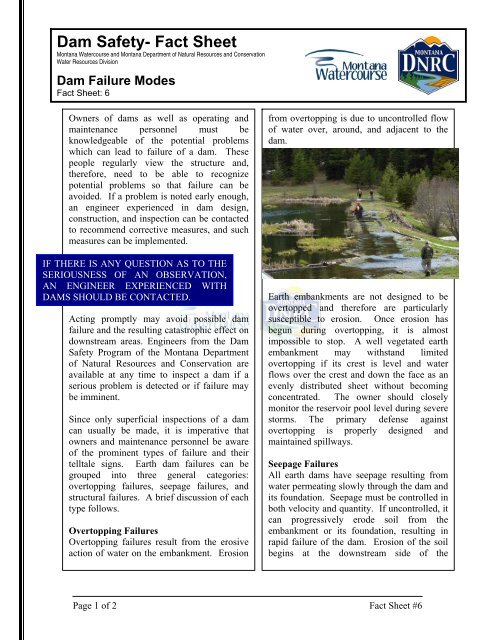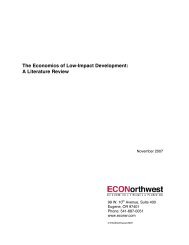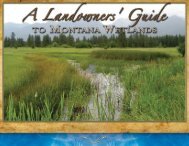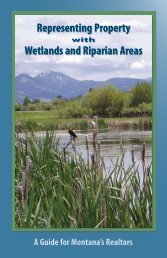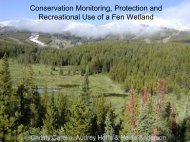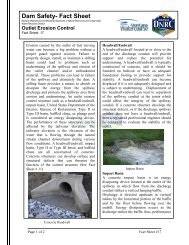Dam Failure Modes - Montana Watercourse
Dam Failure Modes - Montana Watercourse
Dam Failure Modes - Montana Watercourse
Create successful ePaper yourself
Turn your PDF publications into a flip-book with our unique Google optimized e-Paper software.
<strong>Dam</strong> Safety- Fact Sheet<strong>Montana</strong> <strong>Watercourse</strong> and <strong>Montana</strong> Department of Natural Resources and ConservationWater Resources Division<strong>Dam</strong> <strong>Failure</strong> <strong>Modes</strong>Fact Sheet: 6Owners of dams as well as operating andmaintenance personnel must beknowledgeable of the potential problemswhich can lead to failure of a dam. Thesepeople regularly view the structure and,therefore, need to be able to recognizepotential problems so that failure can beavoided. If a problem is noted early enough,an engineer experienced in dam design,construction, and inspection can be contactedto recommend corrective measures, and suchmeasures can be implemented.IF THERE IS ANY QUESTION AS TO THESERIOUSNESS OF AN OBSERVATION,AN ENGINEER EXPERIENCED WITHDAMS SHOULD BE CONTACTED.Acting promptly may avoid possible damfailure and the resulting catastrophic effect ondownstream areas. Engineers from the <strong>Dam</strong>Safety Program of the <strong>Montana</strong> Departmentof Natural Resources and Conservation areavailable at any time to inspect a dam if aserious problem is detected or if failure maybe imminent.Since only superficial inspections of a damcan usually be made, it is imperative thatowners and maintenance personnel be awareof the prominent types of failure and theirtelltale signs. Earth dam failures can begrouped into three general categories:overtopping failures, seepage failures, andstructural failures. A brief discussion of eachtype follows.Overtopping <strong>Failure</strong>sOvertopping failures result from the erosiveaction of water on the embankment. Erosionfrom overtopping is due to uncontrolled flowof water over, around, and adjacent to thedam.Earth embankments are not designed to beovertopped and therefore are particularlysusceptible to erosion. Once erosion hasbegun during overtopping, it is almostimpossible to stop. A well vegetated earthembankment may withstand limitedovertopping if its crest is level and waterflows over the crest and down the face as anevenly distributed sheet without becomingconcentrated. The owner should closelymonitor the reservoir pool level during severestorms. The primary defense againstovertopping is properly designed andmaintained spillways.Seepage <strong>Failure</strong>sAll earth dams have seepage resulting fromwater permeating slowly through the dam andits foundation. Seepage must be controlled inboth velocity and quantity. If uncontrolled, itcan progressively erode soil from theembankment or its foundation, resulting inrapid failure of the dam. Erosion of the soilbegins at the downstream side of thePage 1 of 2 Fact Sheet #6
embankment, either in the dam proper or thefoundation, progressively works toward thereservoir, and eventually develops a directconnection to the reservoir. This phenomenonis known as "piping." Piping action can berecognized by an increased seepage flow rate,the discharge of muddy or discolored water,sinkholes on or near the embankment, or awhirlpool in the reservoir. Once a whirlpool(eddy) is observed on the reservoir surface,complete failure of the dam will probablyfollow in a matter of minutes. As withovertopping, fully developed piping isvirtually impossible to control and will likelycause failure. Seepage can cause slope failureby creating high pressures in the soil pores orby saturating the slope. The pressure ofseepage within an embankment is difficult todetermine without proper instrumentation. Aslope which becomes saturated and developsslides may be showing signs of excessiveseepage pressure. Embankments are mostvulnerable to seepage during high waterconditions.Structural <strong>Failure</strong>sStructural failures can occur in either theembankment or the appurtenances. Structuralfailure of a spillway, lake drain, or otherappurtenance may lead to failure of theembankment. Cracking, settlement, and slidesare the more common signs of structuralfailure of embankments. Large cracks in anappurtenance or the embankment, majorsettlement, and major slides will requireemergency measures to ensure safety,especially if these problems occur suddenly.If this type of situation occurs, the lake levelshould be lowered, the appropriate state andlocal authorities notified, and professionaladvice sought.If the observer is uncertain as to theseriousness of the problem, a licensed engineershould be contacted immediately. The DNRCWater Resource Division has engineers locatedthrough out the state that you can also call forassistance.The three types of failure previouslydescribed are often interrelated in a complexmanner. For example, uncontrolled seepagemay weaken the soil and lead to a structuralfailure. A structural failure may shorten theseepage path and lead to a piping failure.Minor defects such as cracks in theembankment may be the first visual sign of amajor problem which could lead to failure ofthe structure. The seriousness of alldeficiencies should be evaluated by someoneexperienced in dam design and construction.A qualified professional engineer canrecommend appropriate permanent remedialmeasures.For more questions, comments, additional factsheets, and area specific information you cancontact DNRC or <strong>Montana</strong> <strong>Watercourse</strong> at theaddresses below or on the web.<strong>Montana</strong> <strong>Watercourse</strong>PO Box 170570Bozeman, MT 59717-0570406-994-6671www.mtwatercourse.org<strong>Montana</strong> Department ofNatural Resources and ConservationWater Resource Division<strong>Dam</strong> Safety Program1424 9th AvenuePO Box 201601Helena, MT 59620-1601406-444-6613www.dnrc.mt.gov/wrd/water_op/dam_safetyPage 2 of 2 Fact Sheet #6


